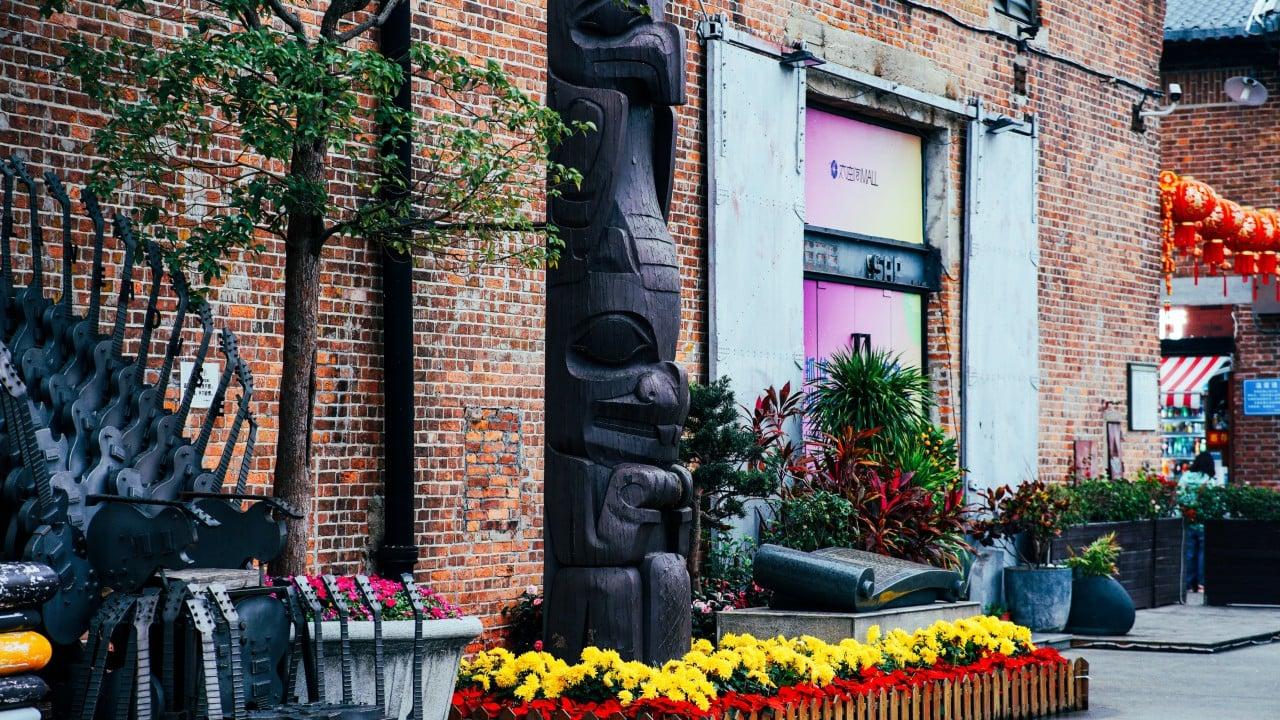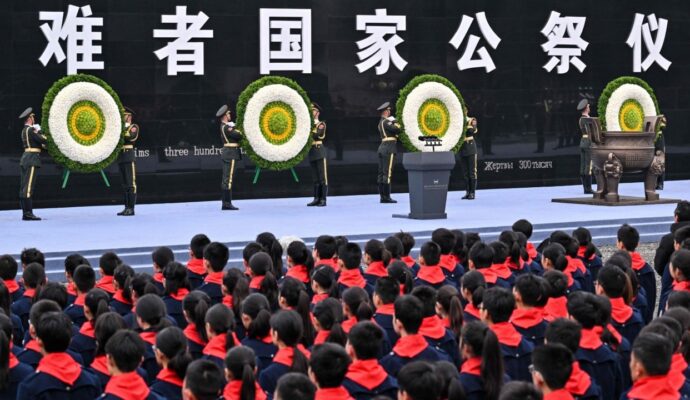
The totem pole was carved by Reg Davidson, a Canadian artist and a member of the Haida people, a First Nations group hailing from the archipelago of Haida Gwaii, off the coast of northern British Columbia near the Alaska Panhandle.
It arrived in China as a gift from the Vancouver Port Corporation to the Guangzhou Port Group on April 11, 1996, to mark the signing of a sister port agreement.
In the olden days, there used to be totem poles at every house, and you knew which clan was living in that house
The deal made Guangzhou’s the third Chinese port to establish formal relations with Vancouver Port, today known as the Vancouver Fraser Port Authority, following agreements with ports in Dalian and Shanghai in 1985 and 1994, respectively.
Davidson was hired by Vancouver Port, at the time chaired by well-known art collector and patron Ron Longstaffe, to create the 3.6-metre (12ft)-tall carving using western red cedar from Haida Gwaii. And the pole has personal meaning to the artist.
“The way the Haida are, there are two main crests: the raven and the eagle. And our main crest is whatever our mother’s crest is, the beaver is a sub-crest of ours,” says Davidson by phone from his home in Masset, a village in the north of Haida Gwaii.
“I decided to do something personal that belongs to me.”
For the Haida people, totem poles have been a significant part of their culture for thousands of years, long predating the arrival of Europeans in the Americas.
Two heraldic totem poles photographed on Canada’s Cormorant Island in the early 20th century represent the owner’s paternal crest – an eagle – and maternal crest – a grizzly bear. Photo: Getty images
Archaeological evidence indicates that the northern First Nations in British Columbia – among whom the Haida are counted, alongside the Nuxalk, Kwakwaka’wakw, Tsimshian and Tlingít – were the first peoples to carve totem poles before the practice spread down the coast as far as Washington state, in the United States.
According to Davidson, most Haida totem poles were a cross between a family crest and a postal address, erected outside the homes of kinship groups to identify the occupants.
“In the olden days, there used to be totem poles at every house, and you knew which clan was living in that house,” says Davidson. “I guess in the olden days in Europe, they used to have flags. People had different flags with their crests or whatever they called it.”
In what is unquestionably a blemish on Canadian history, the totem pole traditions of the First Nations of coastal British Columbia came under threat in the 19th century, when the federal government enacted the Indian Act, preventing Indigenous peoples from exercising long-standing cultural and governance practices.
The legislation paved the way for many of the poles to be removed and sold to private collectors or museums worldwide. At the same time, Christian missionaries deemed the carvings unholy pagan idols that must be destroyed.
“When the churches made contact, they made us cut all [the totem poles] down because they didn’t understand it,” says Davidson, “they thought we worshipped them. We were actually banned for quite a few years from practising our culture.”
More than a quarter of a century before Davidson was commissioned to carve the totem pole for Guangzhou Port Group, aged 14, he was drawn into the world of Haida art to assist his elder brother with a monumental undertaking: carving and raising the first traditional Haida totem pole in nearly a century.
The year was 1969, and the Davidson brothers worked six days a week over three and a half months to carve the pole near their parents’ home in Masset.
“Reg had never carved before, but he was there with me throughout the whole project,” Robert Davidson, Reg’s elder brother and a leading figure in the revival of Haida art, told the Canadian Broadcasting Corporation in 2019, as part of the 50th anniversary of the project.
In the decades following Reg Davidson’s introduction to the Haida’s heritage arts, he became adept at creating silk-screen prints, carved masks, painted drums, jewellery made from precious metals and, of course, carvings such as totem poles.
A street in an indigenous Canadian village with totem poles outside houses, circa 1900. Photo: Getty Images
In the summer of 1980, he and Robert were hired by a Vancouver Island college to create a Haida-style totem pole to be donated to a school in Japan.
The 10-metre, three-tonne (3.3-ton) totem was crowned by an eagle atop a beaver, frog and cormorant. In addition to seeing much of his artistic work displayed abroad, Davidson also travelled to near and far-flung destinations to showcase his craft.
The artist has visited East Asia several times and fondly recalls a Taiwan carving demonstration.
While working on the totem destined for Guangzhou in the 1990s, Davidson notes that for a couple of weeks he commuted from White Rock in suburban Vancouver, near the Canada-US border, to the Vancouver Port Corporation’s grounds to demonstrate his carving technique for curious onlookers.
“The whole carving process probably took two to three months to complete,” he says.
Upon its arrival in China in 1996, Davidson’s totem pole was displayed at the Guangzhou Port Group’s headquarters, where it remained until 2014, when it was relocated to its current riverfront home at the cultural and entertainment zone known as Taigucang Wharf, according to Chinese media.
Its installation at the wharf, a site that was declared a cultural relic protection unit in 2005, received diplomatic and Chinese media attention at the time.
The director general of Global Affairs Canada, Weldon Epp, serving as the consul general of Canada to Guangzhou in 2014, attended the unveiling ceremony along with other consulate staff.
At the time, he commented to Chinese media that the totem pole represents “Vancouver and Guangzhou and the friendship between our governments and people”.
At some point after arriving in the city, Davidson’s creation took on a new appearance – with the pole painted a dark brown and the eagle’s head at the top suffering damage.
Then-consul general of Canada to Guangzhou, Weldon Epp (fourth from left), attends the unveiling ceremony for the totem pole at Taigucang Wharf in 2014.
When presented with images of the 2014 relocation ceremony for the totem, the artist notes that he left the totem pole a natural cedar colour upon completion. “Actually, it looks pretty good,” remarks Davidson of the paint job.
Today, the totem pole continues its silent sentry over riverside happenings at the pier in Guangzhou. Its appearance, though, has further degraded over the past nine years: paint is chipping off, and deep cracks run across its surface.
Adding to the jagged wound on the eagle’s head, the beaver at the bottom of the pole has suffered damage to its hands and tail.
In its current state, the art, previously touted as an emblem of friendship between Canada and China, feels symbolic of the two nations’ broken diplomatic relations.
Despite initial signs of warming engagement when Justin Trudeau came to power, in 2015, including official visits by the prime minister to China ahead of the G20 meeting in 2016 and again in 2017, Beijing and Ottawa have been increasingly at odds.
Any time you have different cultures getting to experience each other, it brings the communities closer together
Following the arrest of Chinese tech executive Meng Wanzhou by the Royal Canadian Mounted Police (RCMP) in Vancouver in 2018 at the request of US authorities, China banned some Canadian agricultural exports and – most notably – engaged in a high-profile act of so-called hostage diplomacy, arresting two Canadians in what was widely viewed as retaliation.
Last year, Chinese fighter jets buzzed Canadian surveillance planes conducting missions to enforce United Nations sanctions against North Korea, and accusations surfaced that Chinese police were operating on Canadian soil. The RCMP also announced an investigation into Chinese interference in Canadian affairs.
In November, on the sidelines of the G20 meeting in Bali, Indonesia, Chinese President Xi Jinping rebuked Trudeau over details of an earlier conversation between the two appearing in the press.
In a clear sign of the times, Epp, who attended the 2014 unveiling ceremony of the totem pole in Guangzhou, last year described China as the largest source of foreign interference in Canada.
At least one other First Nations totem pole is known to have arrived in China before Davidson’s carving: in the 1980s, a nearly four-metre-tall cedar pole was gifted by Victoria’s city government to a public garden in Suzhou, a city west of Shanghai, to mark the establishment of “Twin City” relations.
In 2010, another totem pole made its way across the blue expanse of the Pacific to China, a gift from the Tl’azt’en Nation near Fort St James, British Columbia, to the Qiang people of Beichuan, in southwest China’s Sichuan province, who had suffered terrible losses in the catastrophic 2008 Sichuan earthquake.
The five-metre-tall cedar pole featured carvings of a grizzly bear and eagle and was transported to Sichuan aboard the plane of Canada’s then governor general, Michaëlle Jean, during her visit to China for Expo 2010 in Shanghai.
“It was a gift from the heart to do two things,” Grand Chief of the Tl’azt’en Nation Edward John said at the time. “To honour and remember those who lost their lives in the earthquake.
“The other one was to let the spirits wipe the tears away of the survivors who lost families and relatives.”
Despite the tattered state of Sino-Canada relations, some people in China remain hopeful that symbols of Canadian and First Nations culture can help generate understanding and engagement.
“Any time you have different cultures getting to experience each other, it brings the communities closer together. You end up with less conflict and more understanding of each other, so I can’t see that ever being a bad thing,” says Robert Turnbull, a Canadian entrepreneur who has lived in Guangzhou for nearly two decades and is a member of the executive team for the local Canadian Chamber of Commerce.
“In my mind, it can only be good. It can only bring positive changes.”
Li Meng, a designer who has lived in Guangzhou for three years and requested to use an alias, notes that cultural and artistic gifts signify friendship. As a prominent example, she singles out France’s gift of the Statue of Liberty to the US in the 1880s.
“Although the relationship between the US and France might not be as good as before, the statue serves as a valuable memory, capturing the earlier happiness of the relationship.
“It tells people we were friends and will be friends in the future, even if we aren’t right now,” says Li, strolling through Taigucang Wharf on an overcast January afternoon.
Also visiting the pier is Guan Xiaotong, a 20-year-old college student who hails from Heyuan city, a two-hour drive from Guangzhou. She says she believes cultural exchanges help cut through misconceptions and generate goodwill.
“I think giving such gifts does help to create a better understanding between the two countries’ peoples,” Guan says. “It’s essential for us to know Canada from a different perspective instead of from the mainstream media narrative.”
For his part, Davidson says he hopes his creation will continue to help spread awareness of the Haida people in a country far away from their homeland.
“Hopefully, they understand who we are,” says Davidson, “because not everyone comes to Haida Gwaii.”
Additional reporting by Senki Yu.


